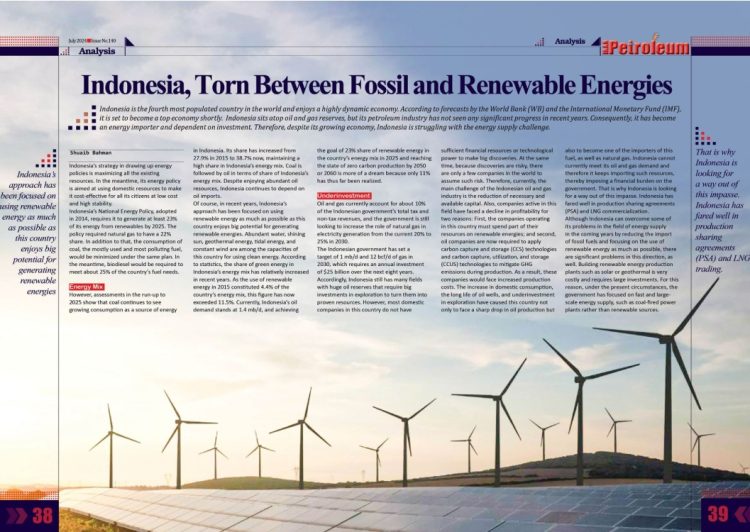Indonesia is the fourth most populated country in the world and enjoys a highly dynamic economy. According to forecasts by the World Bank (WB) and the International Monetary Fund (IMF), it is set to become a top economy shortly. Indonesia sits atop oil and gas reserves, but its petroleum industry has not seen any significant progress in recent years. Consequently, it has become an energy importer and dependent on investment. Therefore, despite its growing economy, Indonesia is struggling with the energy supply challenge.
Indonesia’s strategy in drawing up energy policies is maximizing all the existing resources. In the meantime, its energy policy is aimed at using domestic resources to make it cost-effective for all its citizens at low cost and high stability.
Indonesia’s National Energy Policy, adopted in 2014, requires it to generate at least 23% of its energy from renewables by 2025. The policy required natural gas to have a 22% share. In addition to that, the consumption of coal, the mostly used and most polluting fuel, would be minimized under the same plan. In the meantime, biodiesel would be required to meet about 25% of the country’s fuel needs.
Energy Mix
However, assessments in the run-up to 2025 show that coal continues to see growing consumption as a source of energy in Indonesia. Its share has increased from 27.9% in 2015 to 38.7% now, maintaining a high share in Indonesia’s energy mix. Coal is followed by oil in terms of share of Indonesia’s energy mix. Despite enjoying abundant oil resources, Indonesia continues to depend on oil imports.
Of course, in recent years, Indonesia’s approach has been focused on using renewable energy as much as possible as this country enjoys big potential for generating renewable energies. Abundant water, shining sun, geothermal energy, tidal energy, and constant wind are among the capacities of this country for using clean energy. According to statistics, the share of green energy in Indonesia’s energy mix has relatively increased in recent years. As the use of renewable energy in 2015 constituted 4.4% of the country’s energy mix, this figure has now exceeded 11.5%. Currently, Indonesia’s oil demand stands at 1.4 mb/d, and achieving the goal of 23% share of renewable energy in the country’s energy mix in 2025 and reaching the state of zero carbon production by 2050 or 2060 is more of a dream because only 11% has thus far been realized.
Underinvestment
Oil and gas currently account for about 10% of the Indonesian government’s total tax and non-tax revenues, and the government is still looking to increase the role of natural gas in electricity generation from the current 20% to 25% in 2030.
The Indonesian government has set a target of 1 mb/d and 12 bcf/d of gas in 2030, which requires an annual investment of $25 billion over the next eight years. Accordingly, Indonesia still has many fields with huge oil reserves that require big investments in exploration to turn them into proven resources. However, most domestic companies in this country do not have sufficient financial resources or technological power to make big discoveries. At the same time, because discoveries are risky, there are only a few companies in the world to assume such risk. Therefore, currently, the main challenge of the Indonesian oil and gas industry is the reduction of necessary and available capital. Also, companies active in this field have faced a decline in profitability for two reasons: First, the companies operating in this country must spend part of their resources on renewable energies; and second, oil companies are now required to apply carbon capture and storage (CCS) technologies and carbon capture, utilization, and storage (CCUS) technologies to mitigate GHG emissions during production. As a result, these companies would face increased production costs. The increase in domestic consumption, the long life of oil wells, and underinvestment in exploration have caused this country not only to face a sharp drop in oil production but also to become one of the importers of this fuel, as well as natural gas. Indonesia cannot currently meet its oil and gas demand and therefore it keeps importing such resources, thereby imposing a financial burden on the government. That is why Indonesia is looking for a way out of this impasse. Indonesia has fared well in production sharing agreements (PSA) and LNG commercialization.
Although Indonesia can overcome some of its problems in the field of energy supply in the coming years by reducing the import of fossil fuels and focusing on the use of renewable energy as much as possible, there are significant problems in this direction, as well. Building renewable energy production plants such as solar or geothermal is very costly and requires large investments. For this reason, under the present circumstances, the government has focused on fast and large-scale energy supply, such as coal-fired power plants rather than renewable sources.








